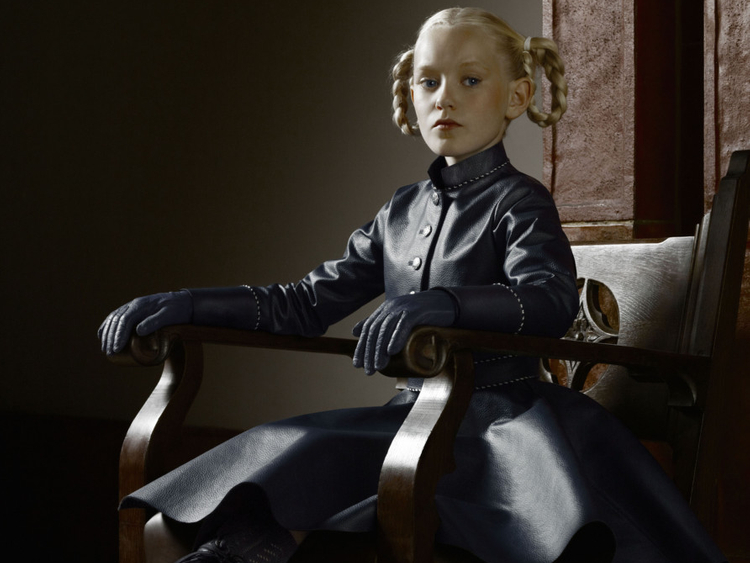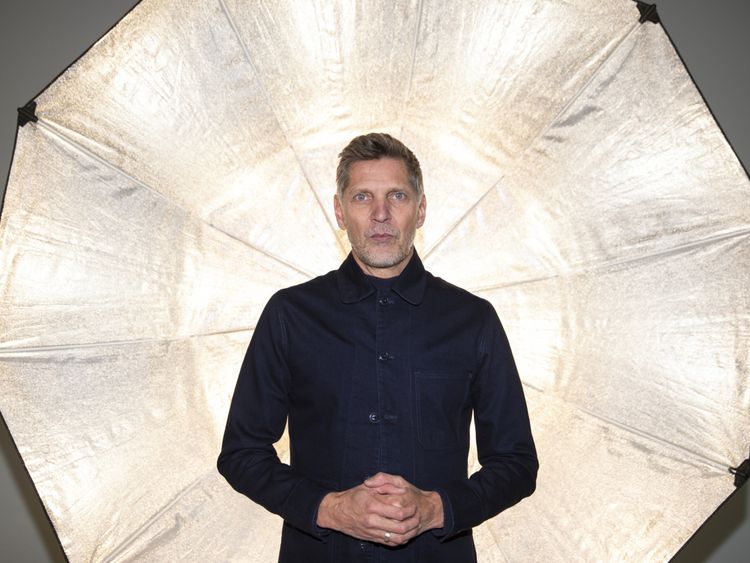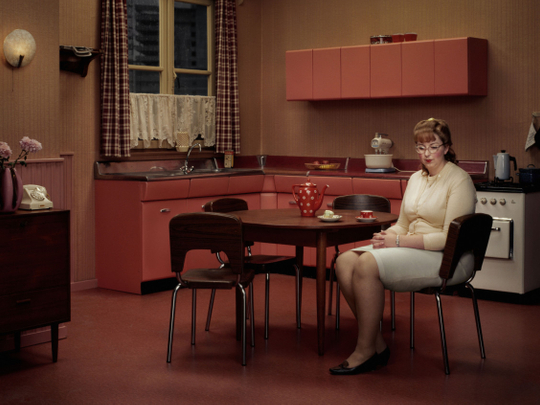
If there’s a single work that encapsulates the artistry of Erwin Olaf, a leading Dutch photographer known for meticulously staged pictures that challenge social taboos and explore human frailty, it might be his 2005 portrait of a young woman in a yellow dress from the Hope series.
The brunette with a yellow ribbon in her hair seems to have just halted in the doorway of her hotel room. She touches her neck with one hand and there is a profound expression on her face. Has she just escaped an argument in her room? Is she hesitating before entering? Or has she been suddenly struck by terrible news?
The photograph contains all of Olaf’s signature technical elements: painterly lighting, formalist composition, styling that we associate with fashion photography — that seductive, perfectionistic polish. Then there’s the final touch that elevates Olaf’s images into the realm of high art, an unsettling feeling. As viewers, we are always compelled to ask: What has happened here?
Olaf turns 60 this year, and three museums in the Netherlands are using the occasion as an opportunity to present retrospectives on his work. The Gemeentemuseum and the Fotomuseum, both in The Hague are showing hundreds of his photographs in two concurrent exhibitions, “Erwin Olaf”, until May 12. At the same time, Aperture is releasing a 400-page monograph, “Erwin Olaf — I Am,” featuring his images starting in the early 1980s.
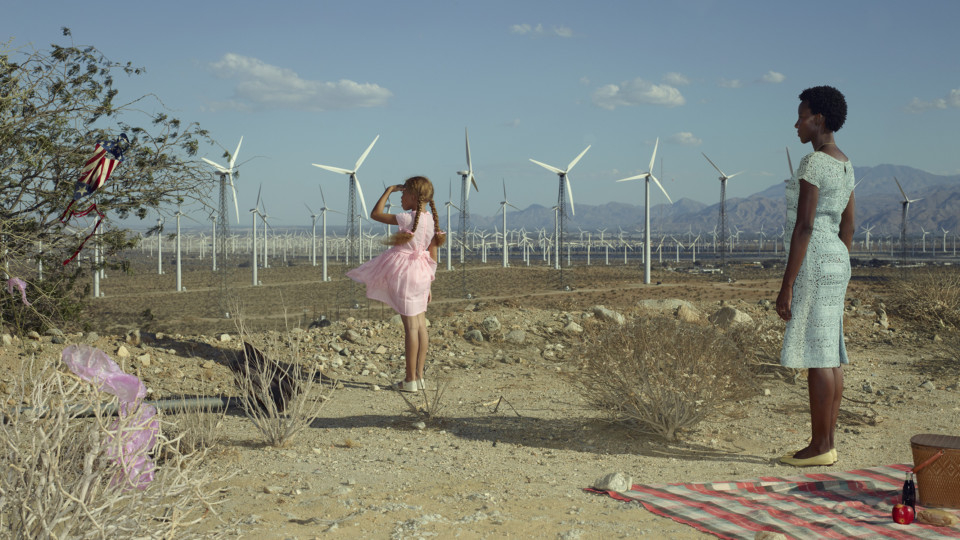
The Gemeentemuseum looks back at the major photographic series that have defined his work since the year 2000, beginning with a group from an imagined American midcentury, consisting of Rain, Hope, Grief and Fall; his high-contrast, mostly white Dusk, and mostly black Dawn. The exhibition continues through his most recent work, the triptych Berlin, Shanghai and Palm Springs, completed last year.
“He’s one of the protagonists of this painterly style of photography, and also the narrative style,” said Wim van Sinderen, curator of both exhibitions. “His are single-image narratives. I always call it one-still cinema. You don’t know what happened before and you don’t know how the story will go on, so it’s one-image cinema, and that makes it very enigmatic and irritating, in a nice way.”
The Fotomuseum will focus on his black and white photographic oeuvre, beginning with his early photojournalism and continuing with his first series, Chessmen, the collection of award-winning images of bound and gagged naked figures posed as medieval chess pieces that launched his career. The exhibition also includes his black-on-black portrait series, Blacks, and follows his working techniques over the years, tracking his progress from analogue photography into the digital realm, van Sinderen said. Images by artists who inspired his work are also part of the show.
Among the Netherlands’s most famous photographers — Rineke Dijkstra, Anton Corbijn and Olaf — he is the least well-known internationally, while in his home country he has been selected for prestigious commissions, such as photographing the Dutch royal family. Last year, the Rijksmuseum, the national museum in Amsterdam, selected about 500 photographs from across his career for its permanent collection, and will present 10 of them in conversation with 10 Golden Age master paintings by artists such as Rembrandt and Gerard ter Borch, in an exhibition that opens in June.
“As opposed to giving the work to a contemporary art museum where he might be seen as part of a photographic avant-garde, here he’s part of a very long and strong tradition of painting and art in general,” Hans Rooseboom, a curator of photography at the Rijksmuseum, said in an interview. “Some of his works are timeless as well, and that will be proven by the exhibition.”
Olaf’s career began in the early 1980s, when, after attending the Utrecht School for Journalism, he worked for a few years as a photojournalist, chronicling the gay liberation movement and the Amsterdam alternative party scene. His first published photos appeared in the Dutch New Wave music magazine Vinyl.
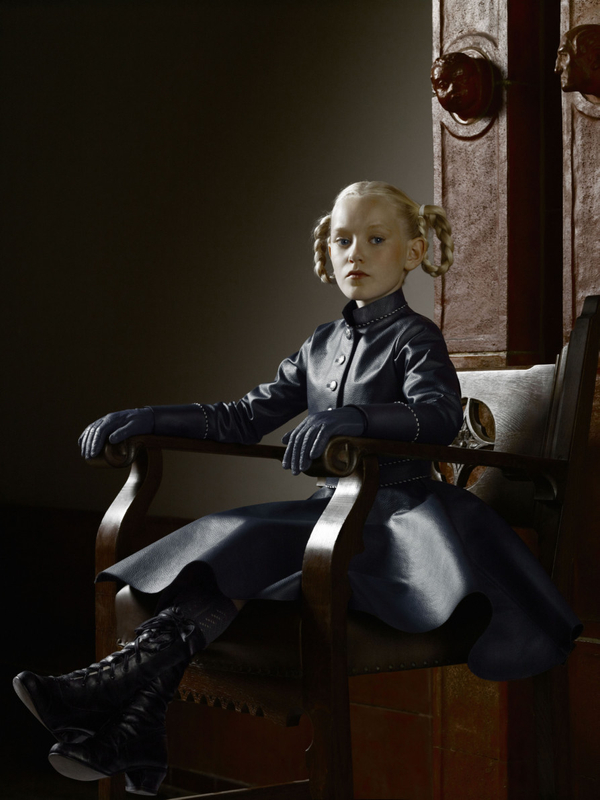
“As a photographer, I liked the daylight but I loved the night life,” he said in an interview at his studio in Amsterdam. “In 1981 the whole society did not know yet know what Aids was, and in the meanwhile, we were dancing on the edge of the volcano, and I really enjoyed it. I was more shy than conservative. I liked to dance on the edge of the volcano and I didn’t want to dive in.”
Olaf experienced it all, but usually from safely behind the lens. Early on, he was influenced by the work of Robert Mapplethorpe and Helmut Newton, and began staging images of disco queens and punks and other party people, often buff and naked, wearing leather bondage harnesses. He shot these mostly in his own room in the squat where he lived at the time, using his friends, and often himself, as models.
“My whole life I really had a difficult relationship with reality,” he explained. “That’s why I moved into the studio. I could stage my own fantasy, my own dream world, my own surrealism.”
In 1988, he won the Young European Photographer Prize for “Chessmen”, catapulting him into a much more professional stage of his career. Amsterdam-based art dealer Martin Rogge of Flatland Gallery has been representing him since shortly after that.
“He does exactly the same thing now that he has done for 30 years: He shows human vulnerability,” Rogge said. Even some of his most vexing imagery, such as his 2003 series Separation, depicting a mother and child clad in full-body black latex who can’t quite reach each other, is a study of human vulnerability, he said.
It might be hard to grasp this quality in Olaf’s photographs at first glance because his images are so exactingly polished — reflecting his years working in the commercial realm, shooting ads for clients such as Diesel Denim, Lavazza and Bottega Veneta. But there is always some unsettling quality within the perfection that encourages the viewer to keep looking. Sometimes the discomfiting element is emotional, seen on the face of the subject, but at other times it comes from some strange juxtaposition or anachronism within the setting.
In his most recent series, Palm Springs, Olaf outfits his models in 1960s clothing and hairstyles and then sets them in contexts that didn’t exist at that time. A mother and daughter picnic in the California desert, for example, gazing out across a vast field of wind turbines first built in the 1980s.
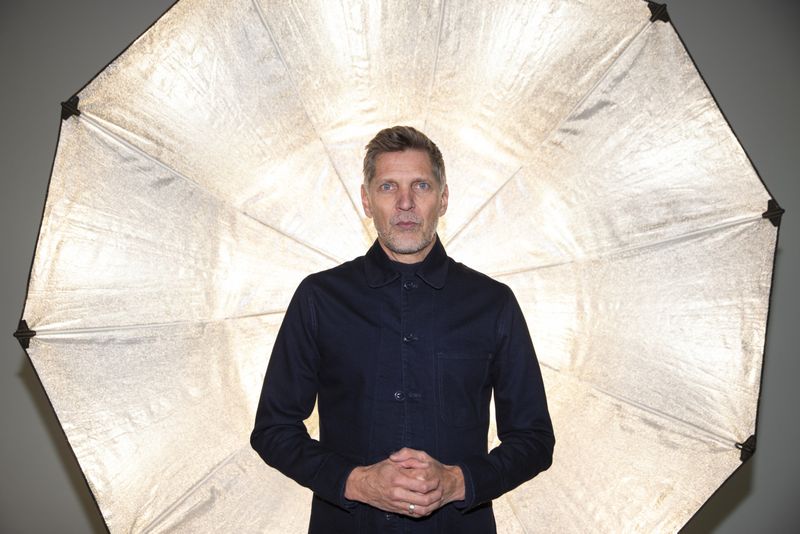
“A perfect world with a crack, that’s what I like,” Olaf said. “That has to do with what’s in here,” he added, pointing to his head. “I think we all have a big crack inside and yet we dress up in our best Sunday suits. I always thought that when I express myself in my personal portfolio I have to be more than 100 per cent honest, toward the viewer and towards myself.”
For his recent series, he has come out of the studio and created his fantasies in real-world settings. It’s a labour intensive process, scouting locations like a filmmaker, hiring actors as his models, and styling every detail on the set. The whole process takes months to prepare, with some 40 crew members in his employ. “I know how to spend my money,” he said. “I don’t have children, I don’t have big cars and I don’t like diamonds.”
He describes his work now as much more “subdued,” but it could be said that the shock value of the early photographs has only been replaced by a stronger submerged tension. The images have an intense surface placidity or stillness, but underneath, they roil.
“You feel emotions but you don’t know what’s triggering this emotion,” van Sinderen, the Gemeentemuseum curator, said. “Is it the environment or is it the model or is it the pose? In this way his work is theatrical but then he knows not to be too abundant, not to give it too much.”
Olaf’s birthday is a milestone with particular significance for the artist because he was diagnosed with emphysema in 1996, and his doctor said then that he probably wouldn’t live to see 60. “I switched hospitals and there they told me I can live to 70,” he told me. “So when I turn 70, I think I will switch to another hospital.”
Even with his illness — and though assistants could certainly do it for him — Olaf still processes all his own black and white photos in the darkroom.
“I really love to print in the darkroom, with music playing; it’s very meditative,” he said. “The craftsmanship of photography is really still very much part of my being. I love to combine the content with craftsmanship. The making of the print is the emotion of the photography — the paper you choose, and the preciseness of the light is very important, the focus and the deepness of the shadow.”
His own sense of vulnerability, or as he describes it, “knowing you’re one of the weak animals in the herd,” is something that drives his focus on his work these days. “It’s a huge advantage that you are aware that you have to live now and not tomorrow,” he said. His health also factored into his decision to donate a large part of his photography archive to the Rijksmuseum.
“It is getting into a different chapter now,” he said. “I have a harsh-sounding voice, walking up the stairs is getting less easy and long-haul flights are harder. It also gives a lot of inspiration. You think about your future, you’re fed up with what you made in the past. It’s automatically combined with some sadness, but you go deeper inside and then you explore new subjects.”
–New York Times News Service




